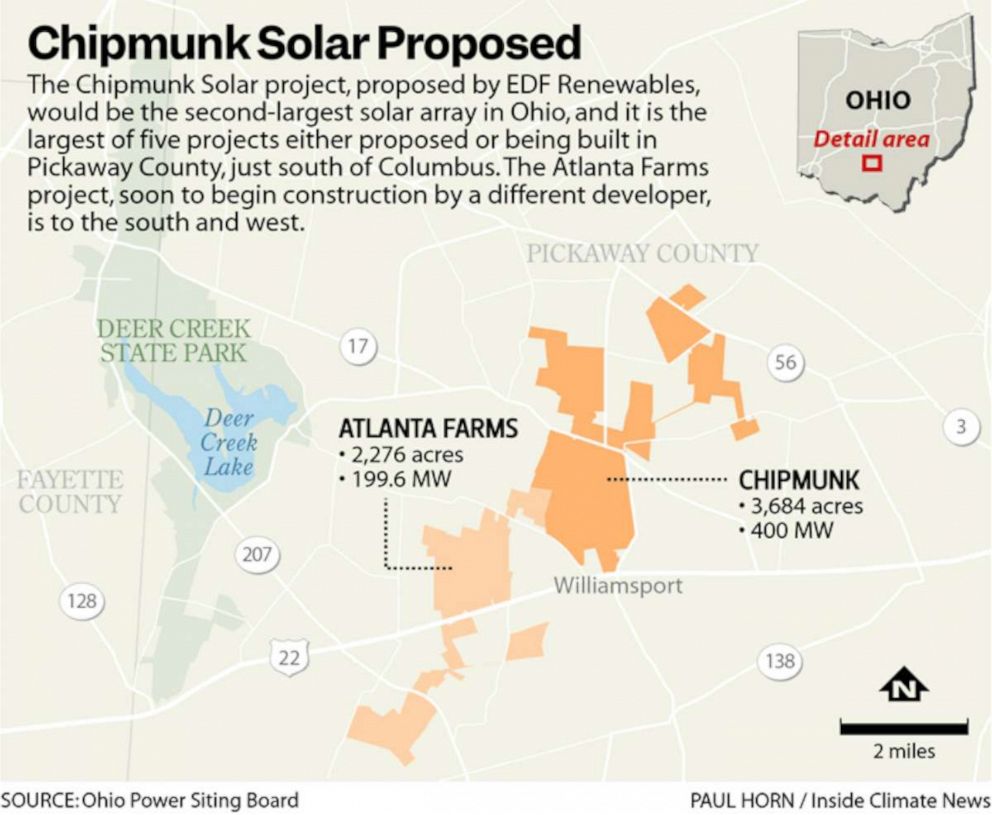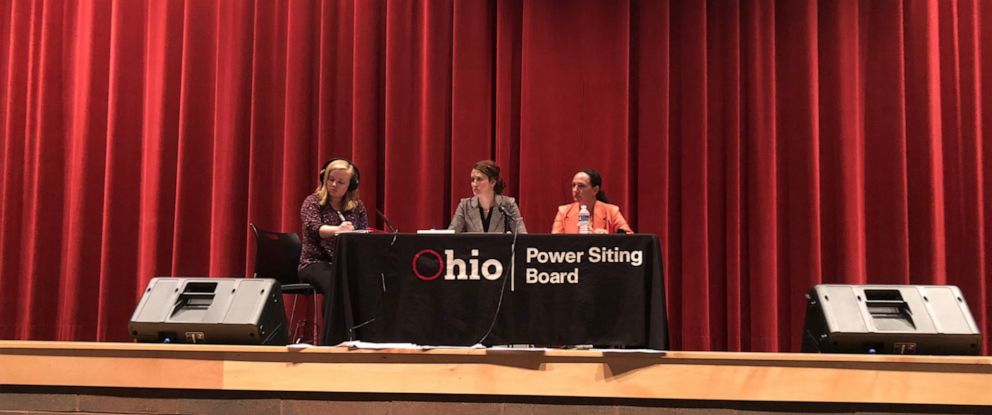In rural Ohio, two supporters of solar power step into a roomful of opposition
Some of the few backers of a solar development in Williamsport stick together.
This article originally appeared on Inside Climate News. It is the second in a series about the conflict over solar power in Williamsport, Ohio, reported in partnership with ABC News. It is republished with permission. Sign up for ICN’s newsletter here.
On a weekday morning in May, Mark Schein drove his truck about a mile up the road and rang the doorbell of Melvin Steck and his son and caretaker Doug Steck. Mark stepped into the kitchen, saw Melvin, who is 101, and let out a joyous, “Hey there.”
Melvin, who is hard of hearing and doesn’t talk much, smiled and offered Mark some peanut M&M’s from a giant-sized bag that was in its usual place in the middle of the table.

Melvin is the last of a generation that farmed alongside Mark’s father, and someone who can remember an era when farm families and communities relied on each other as a matter of economic survival.
Of the dozen or so property owners who leased land for the proposed Chipmunk Solar project, only three live on the land, including the Schein and Steck families. The rest of the properties are owned by out-of-town family estates.
These solar supporters knew they were outnumbered in the community by people who oppose the project, but remained steadfast in their belief that they should be able to do what they choose with their land, and were counting on lease payments from the project to provide financial stability.
Mark, 68, is a retired farmer. Doug, 72, owns a small trucking company. Unlike Mark, Doug is eager to engage with people about the project, including the opponents. This has led to some tense moments, like an argument that ended with Doug nose to nose with a solar opponent at a township meeting.
“I just want them to use facts,” Doug said. “Don’t embellish. Don’t quote somebody else. Use facts.”

He took a seat at the table and shared an important accessory: his three-ring binder, packed with academic papers, news articles, spreadsheets and notes from government meetings.
He aimed to be the community’s fact-checker, but found that some opponents of solar viewed him as self-serving rather than helpful. It was indicative of a broader conflict in rural America over what to believe as renewable energy developers seek vast quantities of land for projects and some residents resist.
EDF Renewables is working to develop the 400-megawatt Chipmunk project, a small part of which would be on the Steck farm. The company has an application pending before the Ohio Power Siting Board; one of the state office’s key questions is whether the community wants the project.
A well-organized campaign has sought to answer with an emphatic, “No.” Opponents have printed yard signs and pamphlets and bought newspaper ads, all arguing that solar would ruin the region’s agricultural character and tank property values.
Notably absent from the debate was almost any mention of climate change.
An upcoming public hearing was an opportunity for the opponents to show their strength, and Doug and Mark planned to be there.
‘Life Is Not Perfect’
Melvin began farming when he was eight, walking behind mules in his parents’ fields. Doug, his only son, grew up driving a tractor and feeding livestock.
Doug knows the feeling of precarity that comes with a life in agriculture. He once had his own farm, separate from his father’s, only to lose it in the early 1980s amid high interest rates and punishing weather.

He remembers a summer day when a dark cloud rolled in and hail began to fall. His corn had been 8 feet tall, and he watched from his house as the balls of ice leveled the crop, killing all of it in less than an hour.
“I had spontaneous shaking, crying, vomiting for three years,” he said. “I’ve already been through the stress of cycles of knowing how bad it can get. Life is not perfect.”
His experience losing the farm is one of the reasons he was receptive to the solar company’s offer of a guaranteed income that would last for decades, an income that would be about five times more than the family would make from renting the land to other farmers.
The project’s opponents have included other families who argue that solar is an industrial use for farmland that will harm the community. But many of the opponents are people who have houses in farm country but are not farmers and do not own farmland.
EDF has led a low-key campaign to build support for the project. There are no pro-solar signs to compete with the anti-solar ones.
EDF said in an email that it has “been very involved in the community by way of solar education, consistent project updates at local township and county meetings, public information meetings” and $50,000 in donations to local civic and charitable groups.
While EDF is taking those steps, the land owners who would host the project have not been a big part of the public outreach. As Mark puts it, “I’m gonna keep my yap shut.”
Objections, Rebuttals and Hypocrisy
Doug opened his binder to a page that summarized objections to the project that he tallied from November 2021 to January 2022, based on comments submitted to the Ohio Power Siting Board and spoken at public meetings.
The top objection, mentioned in one form or another 30 times, was that people don’t like the change to the visual landscape.
The second most common objection, mentioned 26 times, was that the presence of solar would lead to a decrease in property values.
Next, with 17 mentions, were concerns about the loss of farmland. This was nearly tied with concerns about the loss of wildlife.
After that, with 15 mentions, was a category Doug summarized as “environmental concerns.”

He said his goal was to understand and investigate the objections with an open mind. For example, he understood the perspectives of people who don’t like the idea of a major shift in the view out their back door. But he noted that only a tiny share of the population lives within sight of the project.
Meanwhile, the worries about a major drop in property values were bogus, he said. Key studies on the subject found that solar development leads to, at worst, small decreases in property values.
As for environmental concerns, this was where he saw hypocrisy. Depending on the manufacturer, solar panels may contain some harmful materials. But there was little evidence that the panels would leak those materials into the environment at a scale that would affect human or animal health.
The hypocrisy was that many opponents of the project were talking about leaks from solar panels while they had no problem dumping tons of fertilizers and chemicals on farmland, practices that are much more destructive to the environment. He made this point with a spreadsheet showing the tonnage of fertilizers, pesticides and herbicides placed on his family’s 285 acres over a 10-year period.
“That’s all poison,” he said.
Doug was hopeful that having a solar array on the land would allow for a much-needed period for the soil to recover as native grasses grow underneath and reduce harmful runoff.
Mark and Doug felt like the case for solar was so strong that some neighbors could be convinced, and wondered if objections were coming from a vocal minority.
They were about to find out.
Feeling Outnumbered
On a Wednesday in May, Doug and Mark walked into the Circleville High School auditorium. Circleville, known for its annual pumpkin festival, is a short drive from Williamsport. The school was hosting a public hearing held by the Ohio Power Siting Board to aid in its decision about the region’s solar projects.
Officially, this hearing was about the Scioto Farms solar project, one of the five proposed or under construction in the region, but many people wanted to talk about other projects, like Chipmunk.

The crowd was teeming with solar opponents.
The third person to speak was Garrett Wells, 12, an opponent of the project who was shorter than the microphone stand.
“We love where we live,” he said. “My family has always farmed, and I hope to one day grow up and farm.” The crowd roared with applause.
Some speakers broke down in tears, talking about how their property values will plummet and they will have nothing to leave to their children and grandchildren.
Some talked about health effects, including Chris Weaver, who lives about 100 yards from the project.
“I'm a firm believer in property owners being able to do what they want with their property,” Weaver said. “Until it defaces my property (and) quite possibly destroys my health.”
Doug and Mark exchanged glances and sunk into their seats. The opponents outnumbered the supporters nearly 10 to 1.
Neither Doug nor Mark signed up to talk because they thought the comments would be limited to the Scioto Farms project. Mark could feel the hostility all around him.
He nudged Doug and turned his head to motion toward the door. Doug nodded yes.
“I’d seen enough,” Mark said the next day.
A decision on the Chipmunk project is likely to come by early 2023. But that night, it was clear that the opponents were winning.
They had succeeded in casting solar, an essential resource for the transition to clean energy, as a destroyer of community, and Doug wondered if there was any way back from that.



